The First Japanese Motor Passenger Liners
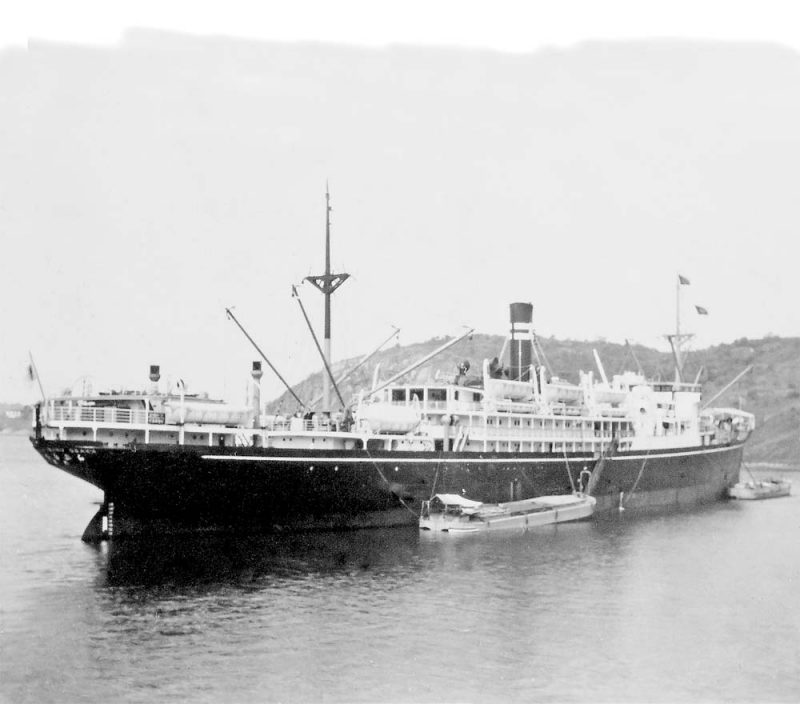
This trio of motorships were memorable for the very good reason that they were the first Japanese passenger motorships, and the first of their type under the Japanese flag to voyage around the world on liner services. They travelled westward on their emigrant service to Brazil via ports in the Far East, South Africa, and South America and returned via ports in the United States and the Panama Canal. The Japanese in the early 1920s had no knowledge or expertise in marine oil engines.
Thus, a dozen diesel engines were ordered from Swiss, Danish and British diesel engine manufacturers to be fitted in ships to be completed between 1923 and 1925. Six Sulzer two stroke cycle diesels were ordered from the Wintherthur engine works in Switzerland for fitting into the twin screw Santos Maru, La Plata Maru and Montevideo Maru, with the condition that the third set would be built under licence at Nagasaki, and that parts and technical personnel would be seconded to Japan so that Japanese marine engineers could acquire the necessary expertise. A pair of four stroke cycle Burmeister & Wain oil engines from Copenhagen were ordered for a twin screw coastal passenger and cargo ship, and a quartet of four stroke cycle diesel engines were ordered from Vickers of Barrow to fit into four coasters of 700 grt.
Osaka Shosen Kaisha (OSK)
Osaka Shosen Kaisha was established in 1884 and began to enter the Transpacific trade to the United States of America in 1906, with a ship sent at the end of that year with coal to San Francisco, and she returned to Japan with flour and wheat. The service prospered and large OSK emigrant and cargo steamers were built for this trade, with the OSK fleet having reached a big strength of 135 steamers by 1920. The biggest passenger steamers in the fleet were six of 9,500 grt with accommodation for 42 First Class passengers, 316 in Third Class, and up to six hundred steerage passengers in the ‘tween decks. The new trio of Santos Maru, La Plata Maru and Montevideo Maru were to be smaller at 7,300 grt with a capacity to carry 7,200 tonnes of cargo in five capacious holds. The keel of Santos Maru was laid at the Nagasaki yard of Mitsubishi Zosen Kaisha on 5th January 1925 and she was launched in September 1925, and after her new Swiss built diesels were fitted, she underwent speed trials in November 1925, and attained a speed of 16.419 knots at 4,690 bhp at 119 rpm in ballast over the measured mile, and a speed of 15.754 knots when half loaded and at 117.8 rpm. This more than satisfied the owners of OSK that the new trio of motorships would be able to achieve a tight schedule on their Round the World service.
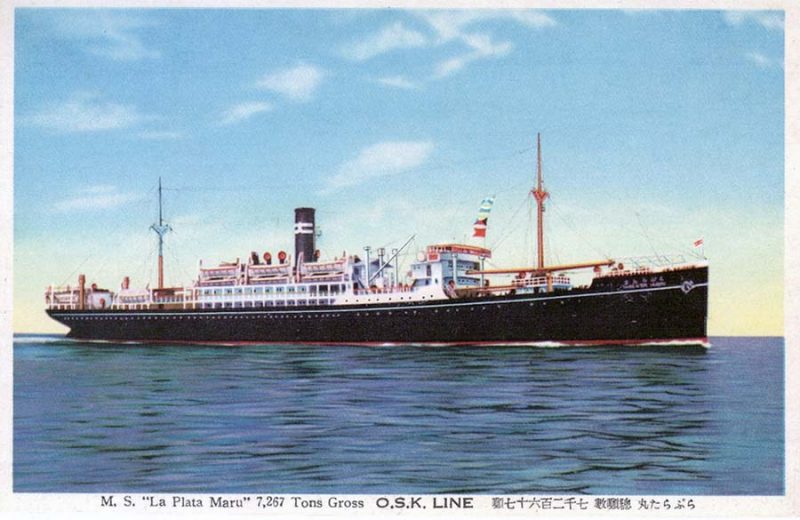
Specification Of The Trio Of Motorships
The trio were specified to be built with three complete steel decks, namely and working downwards Awning Deck (or Weather Deck), Upper Deck and Second Deck, with the Third Class and steerage passengers occupying the full length of Upper Deck. There were two partial decks above in Bridge Deck and Boat Deck with the forty First Class passengers in cabins in some style ‘midships on Bridge Deck. The hull was subdivided into seven watertight bulkheads to give six compartments with three holds forward of the engine room and two aft. The cargo holds and ‘tween decks had a total capacity of 360,000 cubic feet, with separate large rooms on Second Deck for the important export trade from Japan of refrigerated goods, silk and rice. Awning Deck (or Weather Deck) had a deckhouse ‘midships 100 feet in length where the engineers and other members of the crew were accommodated. Forward of this crew accommodation on the starboard side was the Third Class Dining Room and on the port side various offices and crew members cabins. At the aft end of this deck was a deckhouse with the Third Class wash-houses, lavatories, laundry and the steering gear. In the space aft between numbers 4 and 5 hatches was a smaller deckhouse with the steerage class latrines and their entrance from the deck below. The seamen were accommodated in the fo’c’stle of this deck, and a second small deckhouse was sited between numbers 1 and 2 holds for the steerage class entrance from the deck below. Bridge Deck extended for a distance of 175 feet, and the main accommodation was that of the First Class cabins, and First Class Dining Room, and forward of these across number three hatch were the Officers cabins. In the two well decks at the level of Bridge Deck were the winch and derrick platforms, and at the stern were four lifeboats on the aft winch platform as well as the ship’s hospital further aft. Boat Deck was 120 feet in length with a further six lifeboats as well as the First Class Smoking Room and adjoining Verandah Cafe, and the First Class Social Hall or Lounge. The navigating bridge was at the forward end of Boat Deck with the Dayroom and Bedroom of the Master, Chart Room, Wireless Room, and Wireless Operat-or Cabin. The wheelhouse was situated on a flying bridge above the navigating bridge.
The public rooms and cabins for First Class passengers are now described:-
- The First Class Dining Room was immediately forward of their cabins on Bridge Deck with seating for all forty passengers in one sitting. The decor was in the ‘Colonial Renaissance’ style, with white and grey painted wooden panelling, and a matching ceiling of white panels. Large twin windows with top lights gave more than ample light through large wood framed sliding sashes of stained glass, and with gorgeous coloured floor tiles gave the room its neo luxury feel.
- The First Class Lounge or Social Hall on Boat Deck was beautifully decorated in full Japanese style of the Toyotomi era. The red and white fabric of the sofas, carver chairs and other Japanese furniture were a joy to relax in, and the walls had twin bands of brown wall cloth closely placed together with magnificent framed paintings of Mount Fuji and other iconic Japanese scenes in between. These painting were of course by a Japanese artist and drawn on silk in their usual style. The skylights of the ceiling were in elegantly designed stained glass, and were subdivided by brown wood into rectangular sections each with a large Japanese lantern, the latter also being placed centrally on all of the walls. The refined tone of this room was very apparent.
- The First Class Smoking Room on Boat Deck was a complete contrast with decor in the ‘Scottish Jacobean’ style with woodwork of polished oak. An imitation log fire was placed in the large fireplace and the room had a very cosy feeling with occasional tables and card tables for passengers to while away the voyage. As in the First Class Lounge, the central skylights were in elegantly designed stained glass, and the floor was fitted with beautiful coloured tiles.
- The First Class Entrance Hall had painted panel walls, while the stairwell and staircase were in polished oak.
- The First Class Verandah Cafe was an open room immediately aft of the First Class Smoking Room on Boat Deck, and had an ample number of cane settees, tables and chairs, with the walls of the bulkhead being roughly chipped to give imitation stone edging, the overall effect being of a small stone house partly open to the elements.
- First Class Cabins were all two berth, being twenty in number ‘midships on Bridge Deck for the forty passengers. They all were furnished with a comfortable sofa, a wardrobe with drawers and mirrors, a fold up toilet, an electric rotating fan, a steam radiator with separate controls, a beautiful carpet, and two large square metal sliding windows to allow air and a view to be obtained.
- Third Class and steerage class accommodation was very poor in contrast to that of First Class, with 110 Third Class passengers in cabins with ten, eight or six berths immediately forward of the machinery spaces, and the rest of this cargo deck had rudimentary portable fittings and space for up to six hundred steerage passengers or cargo, whichever was in most demand on each voyage. The promenading spaces for both of these classes of passenger were on the open portions of Awning Deck (or Weather Deck) above.
Careers of the Trio of Motorships
Santos Maru sailed on her maiden voyage in December 1925, and was followed by her sisters La Plata Maru in April 1926 and Montevideo Maru in August 1926. The main purpose of their Round the World service was to dramatically increase the Japanese population in Brazil, which grew from about 50,000 plantation workers in 1925 to 193,000 workers in 1935. A voyage from the Japanese ports via the Cape of Good Hope in this trio to Santos, the main port of disembarkation, was of 45 days duration. The full Round the World voyage was of 70 days duration, and thus each motorship completed four or five emigration round voyages per year. The full outward port rotation was:-
- Kobe, Yokkaichi, Yokohama, Kobe (second call), Hong Kong, Singapore, Colombo, Durban, Cape Town, Santos, Rio de Janeiro, Montevideo, Buenos Aires.
- Santos, Rio de Janeiro, Belem, Cristobal, Panama Canal, Los Angeles to Yokohama and Kobe.
- Optional calls if sufficient inducement included Shimizu, Port Elizabeth, East London, Rio Grande, Rosario, Santa Fe, La Plata, Victoria, Angra dos Reis, Maceio, Pernambuco, Fortaleza, Curacao, Havana, New Orleans and Galveston.
The peacetime voyages of the trio numbered over two hundred and were routine except for one of Santos Maru when she arrived at New Orleans on 11th June 1932. She was carrying an ‘alien’ passenger on a through ticket to Japan from Brazil, and the immigration officers issued a written warning for the officers to keep the ‘alien’ onboard at all American ports.

Unfortunately, he escaped at the next American port of call of Galveston and this was reported to the immigration authorities. Santos Maru sailed as usual from Galveston, with the ‘alien’ recaptured and deported on the following OSK Line sailing. Santos Maru was ‘impersonated’ by the German East Africa liner Windhuk in early December 1939 when the latter had been ‘trapped’ at Lobito since the beginning of the war and wanted to make a break out back to European waters and a German port.
The commerce raiding operations of the German pocket battleship in the Indian Ocean and South Atlantic complicated matters for a further two months. Finally, Windhuk sailed for Santos in Brazil and the ship and her German crew entered that port on 7th December 1939 renamed as Santos Maru and flying a small handmade Japanese flag. After reaching her berth, her correct name was repainted on her hull, but she was prevented from sailing and was impounded by the Brazilian authorities and later sold in early 1942 to the United States to become an Allied troop transport.
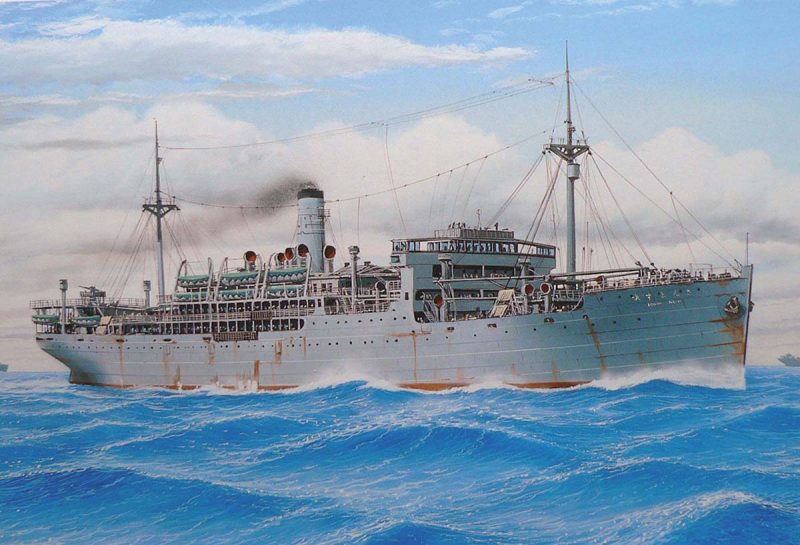
War Careers Of The Trio Of Motorships
Santos Maru sailed on her last peacetime voyage from Japanese ports in April 1940, and on her return to Japan she made regular voyages from Kobe to Dairen in China until laid up at the end of the year. She was then converted in 1941 into a submarine tender for the Imperial Japanese Navy and renamed Manju Maru. She sailed in February 1942 to Staring Bay at Kendari (Celebes) to salvage submarine I-5 from a reef and then carried out repairs to the vessel. In April 1942 she was the submarine tender for the submarine division of Rear Admiral Ichioka Hisashi, and then at the end of May 1942 she was stationed at Kure Naval Yard as tender for submarines I-34 and I-35. She was then reclassified as a Miscellaneous Armed Auxiliary and fitted with one 5.9 inch gun on the bow, four 25 mm anti-aircraft guns, two smaller machine guns and a depth charge thrower. She escorted a total of ten convoys from March 1943 to November 1944 to the Philippines, Truk Lagoon in the Carolines, and Japanese forward bases in the Marianas. She sailed from Manila on 23rd November 1944 for Takao in Japan carrying a large number of Japanese troops as well as 430 survivors from the battleship Mushasi, sunk a month earlier. She was escorted by two patrol boats and a submarine chaser but was sighted the next day by the American submarine Atule, which torpedoed her just after midnight in number five hold. One patrol boat was also destroyed, and Manju Maru sank at 0510 hours with the loss of 700 Japanese troops and two dozen of her crew. She sank around one hundred miles north of Cape Engano, the most north easterly point of Luzon in the Philippines.
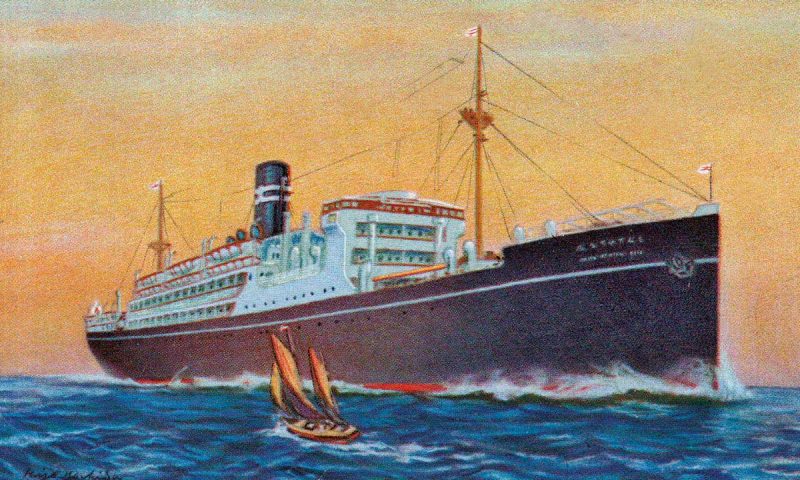
La Plata Maru was the target in January 1940, while still employed on Brazilian emigrant voyages, of British Naval Intelligence that she may be carrying German men of military age. This led to the Asama Maru incident and a flurry of diplomatic communication between the two countries that led both OSK and NYK ceasing to carry German passengers of military age. The twin funnelled Asama Maru had been intercepted by the British cruiser Liverpool on 21st January 1940 when 35 miles from Cape Noshima on the Japanese coast on one of her regular voyages from San Francisco. The British officers removed 51 German Merchant Navy officers and crew from the liner Columbus, destroyed by fire by her crew off the coast of Virginia one month earlier when the liner was intercepted by the British destroyer Hyperion. The German crew had crossed by train from the American east coast to San Francisco and boarded Asama Maru to eventually return to Germany. Liverpool took the German crew to Hong Kong at top speed to evade Japanese destroyers and the detainees were placed in a military prison.
The diplomatic protests by Japan to Britain over the incident were intense, but were eventually sorted out by diplomatic pressure, but anti-British feeling remained in Japan. La Plata Maru was renamed Kanju Maru in 1941 and towards the end of the war when the Allies were clearing out Japanese troops from French Indo China, Kanju Maru was sunk by bombing from United States Navy aircraft in the Saigon river on 12th January 1945 and was left in a flooded derelict state.

Montevideo Maru was the subject of the worst ever maritime disaster, in terms of lives lost, that befell the Australians, resulting in the loss of 1,053 Australian prisoners of war and civilian internees. She sailed from Sourabaya on 28th May 1942 for Rabaul in New Britain, where all of the captured Australian troops and civilian internees had been placed in a prison camp. On 22nd June 1942, 845 Australian troops and 208 civilians were marched from the prison camp to the dock and into the holds of Montevideo Maru.
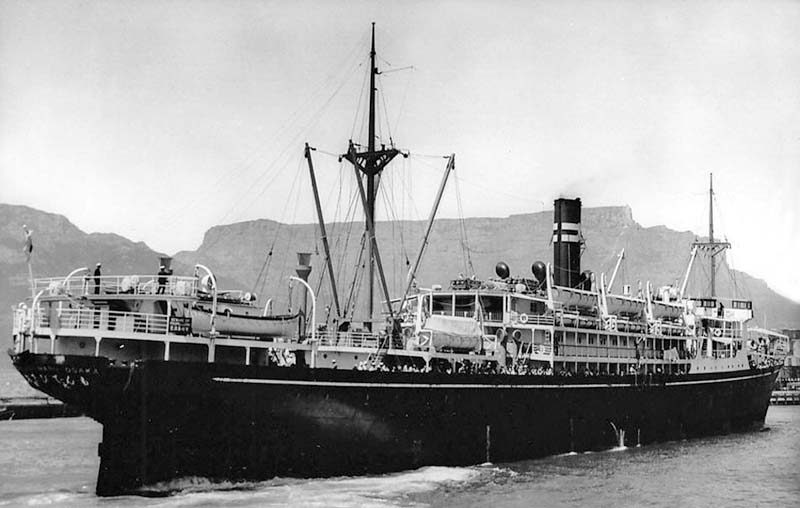
They were bound for another prison camp in Hainan Island, but got only as far as Cape Bojeador, the most north westerly point of Luzon in the Philippines, where their ship was sighted by the American submarine Sturgeon at maximum range and zig-zagging to avoid torpedoes on 30th June. The American submarine could not catch her at the Japanese vessel’s full speed of over seventeen knots, but remarkably Montevideo Maru slowed to twelve knots to meet two Japanese escorts for the last part of the voyage across the South China Sea. This allowed Sturgeon to catch her up and at 0225 hours on the next morning she fired four torpedoes at a range of 4,000 yards, two torpedoes hitting her ‘midships. She sank in less than ten minutes later stern first, and detailed research after the war showed beyond doubt that the Japanese guards deliberately battened down the hatches to the holds from where the Australians stood no chance of escaping.
The brutality of Japanese troops was also well known to my uncle Harry Lea, who was captured along with 150,000 British troops at the surrender of Singapore on 15th February 1942. He and his colleagues were forced to build the infamous bridge over the River Kwai as well as the railway northwards through Burma, continually harassed by starvation, disease and ill treatment by their Japanese guards. Marching and building the railway required all of the British troops to stay within a few yards of the railway line, those that strayed into the jungle, even for toilet relief, meant machine gunning and certain death. After the railway was complete, he was then shipped in a Japanese cargo vessel across the South China Sea to work in the mines on the Japanese mainland. He was one of the few survivors of these Japanese outrages, and when he arrived home via a British aircraft carrier across the Pacific, a Canadian Pacific train to Montreal, and a Cunard troopship home to Liverpool he weighed less than five stones. It took two years of careful treatment and recovery to regain his health in order that he could marry his childhood sweetheart, Vera. Such was the horror of his wartime experiences that he never forgave the abject cruelty of his Japanese guards, and no Japanese consumer goods, cars or other post-war products were ever purchased by our two families.
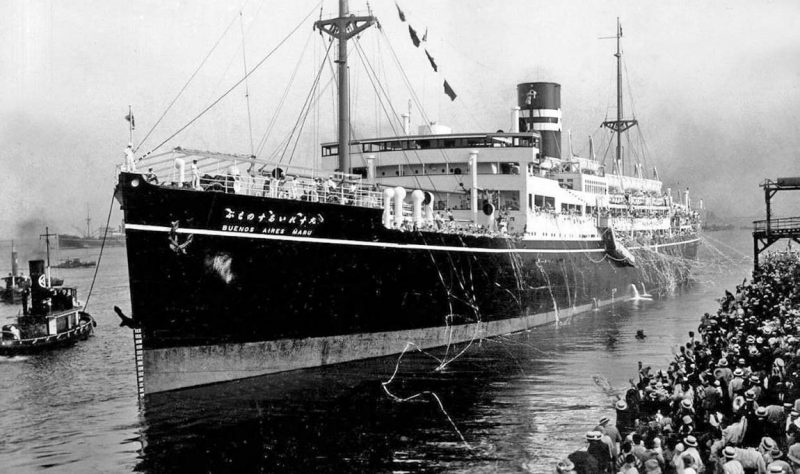
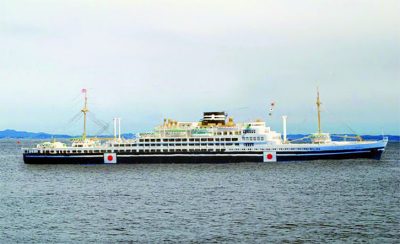
Further OSK Passenger Liners
OSK commissioned another four large passenger and cargo-liners before the start of World War II for the Brazilian emigrant trade. Buenos Aires Maru and Rio de Janeiro Maru were completed in 1929/30 by the Mitsubishi yard at Nagasaki as motorships of 9,627 grt on dimensions of length 473.0 feet, moulded beam of 62.0 feet, moulded depth of 26.0 feet and service speeds of 16.6 knots at 6,760 rpm from twin Sulzer diesel engines. They had accommodation for sixty First Class passengers and over one thousand agricultural workers in steerage class. Buenos Aires Maru was sunk by U.S. aircraft on 27th November 1943, and Rio de Janeiro Maru was sunk by U.S. aircraft during Operation Hailstone on 17th February 1944.
The larger pair of Argentina Maru and Brasil Maru of 12,755 grt were completed by the same yard in 1939, Argentina Maru being launched on 9th December 1938 and completed on 31st May 1939. They had dimensions of length 544.6 feet, moulded beam of 68.9 feet, moulded depth of 29.0 feet and loaded draft of 26.5 feet. They had accommodation for 170 First Class passengers and around 750 Third Class passengers, with top speeds of 21.5 knots from twin Sulzer diesel engines.
Brasil Maru was sunk by the U.S. submarine Greenling on 5th August 1942, and Argentina Maru was converted into the escort carrier Kaiyo and suffered the same fate. Two replacement passenger liners were constructed in 1954 and 1958 by the Mitsubishi yard in Kobe as Brazil Maru and Argentina Maru with accommodation for a total of 375 passengers, 23 in First Class and 352 in Economy Class. They were of 10,907 grt and had dimensions of length 156.5 metres with a summer loaded draft of 8.722 metres. They were powered by Mitsubishi Sulzer diesels of 9,000 bhp and had a top speed of almost twenty knots.
The Japanese Community In Brazil
The ancestors of most of the current population of 1.3 million Japanese living in Brazil today were transported there by the seven inter-war passenger liners described in this article.
The first small group had arrived in Brazil on the steamer Kasato Maru in 1908, with 10,000 Japanese migrants arriving between 1917 and 1925, and the seven passenger liners transporting 150,000 migrants between 1925 and 1941.
The total Japanese population transported between 1908 and 1978 numbered one quarter of a million. This huge influx of workers found employment in the coffee and tea plantations, forestry and farming, silkworm breeding, or opened shops and stores in Santos and Sao Paulo. In addition to market gardening, a smaller contingent of Japanese farm workers cultivated pepper in the heat of the mouth of the Amazon.
The Japanese in Brazil are the most studied group of all South American immigrant communities. Many Japanese by 1950 had saved enough money to buy their own land in Sao Paulo State. Those immigrants that gained professional qualifications lost their native language, and the turmoil of trade slumps in the 1980s, 1990s and between 2008 and 2014 resulted in a quarter of a million Japanese returning to their native Japan.
Today, Sao Paulo is a thriving city of ten million people of the largest city in the whole of the Southern Hemisphere.
They work in the major industries of coffee and sugar packing, cars and vehicles plants, machinery, electrical goods, textiles, pharmaceuticals, aluminium plants and many other industries.
The nearby Port of Santos ships large amounts of sugar, coffee and agricultural products as the largest port by volume of trade in Brazil, and particularly from the hinterland of Sao Paulo State, with a large population of 35 million people. The Japanese community has greatly helped in building this thriving and prosperous part of Southern Brazil.
Postscript
I wish to thank the detailed research done by Rabaul born Anne McCosker into ascertaining the exact disaster that befell the Australian troops and civilian workers that sailed from Rabaul to their deaths on Montevideo Maru.
All Japanese records on the transport of Allied prisoners of war were destroyed a few days before the end of the war. Anne has written at length on the history of the Australians in New Guinea and New Britain, and her research had to start in post-war years from the large number of missing Australians, whose relatives had no idea how they had died.

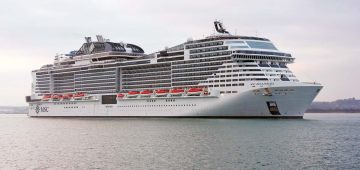



Comments
Sorry, comments are closed for this item